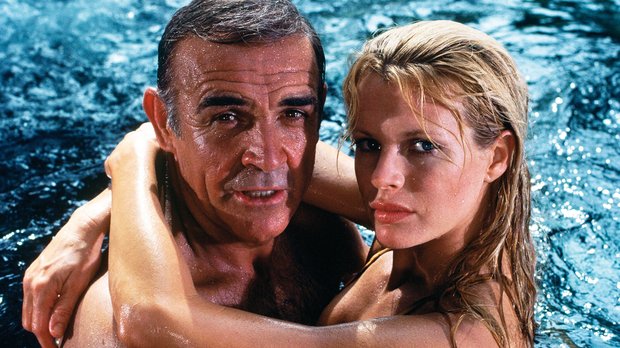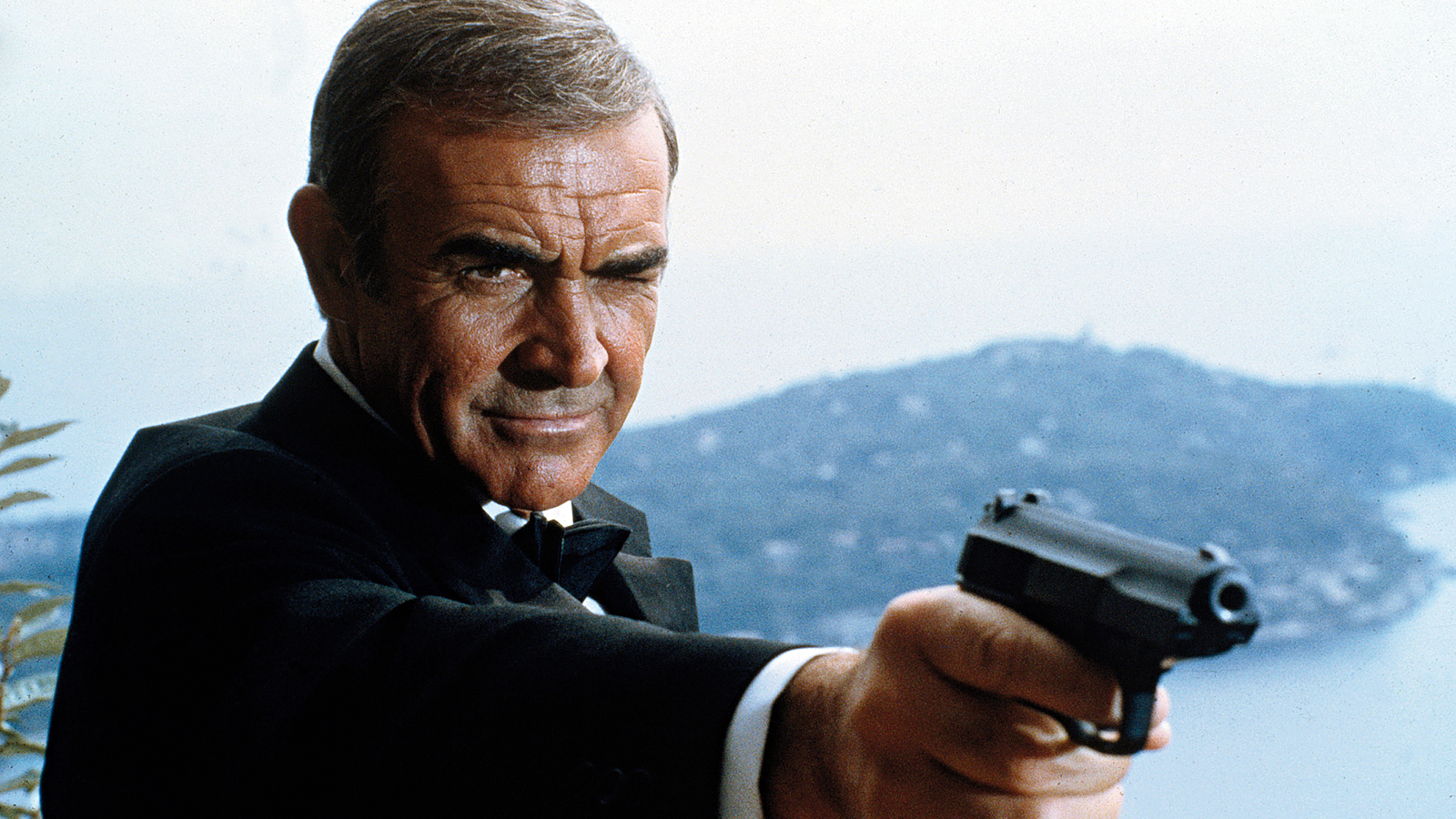“The name’s Bond. James Bond.” In the official pantheon of 007 movies this iconic line has been spoken by no less than six performers – with, arguably, none more legendary than Sean Connery. When he chose to explore new acting avenues after 1967’s You Only Live Twice, Eon Productions – home of Bond’s cinematic exploits – went into a tailspin. While the unknown Australian model George Lazenby would eventually win the much-coveted part in 1969’s On Her Majesty’s Secret Service, he too would flee the franchise. But you should never say never...

Consequently, with a multi-million dollar salary, a share in the box office and the promise of starring in any two non-Bond films of his own choosing, Connery would be convinced to make a one-time only comeback with 1971’s Diamonds Are Forever. The result was a box office blockbuster (in comparison to the commercial apathy that greeted On Her Majesty’s Secret Service) and that, it would seem, was that. Roger Moore and his perpetually-raised right eyebrow made his debut with Live And Let Die in 1973 and Bond continued to enthral subsequent generations...
Yet, there was just one problem: when Ian Fleming released his novel of Thunderball in 1961 it was adapted from a story for a potential Bond movie which had been co-written by independent producer Kevin McClory and his screenwriter friend Jack Whittingham. Having found themselves uncredited in the final book, McClory took Fleming to court, resulting in a settlement. McClory would produce the film adaptation of Thunderball (released in 1965) and, for ten years, agree not to bring the story to the big screen again. To his credit, McClory played ball – but when Eon saw an advertisement in Variety, on 12 May 1976, proclaiming that a remake of Thunderball called James Bond Of The Secret Service was now in pre-production, all hell broke loose.

Inevitably, lengthy legal proceedings followed amid rumours that none other than Connery, who had bemoaned his treatment by Eon, was slated to appear. “Before I put my nose into anything, I want to know it is legally bona fide,” teased the superstar Scotsman in a 1978 interview. McClory claimed that he owned the rights to the franchise’s perennially villainous organisation SPECTRE, having invented them for Thunderball. The immediate effect was a drastic rewrite of Moore’s next outing The Spy Who Loved Me, which was scheduled to highlight the ultimate battle between Bond and Blofeld.
As press interest in the legal battle between Eon and McClory went into overdrive, eagle-eyed reporters managed to spot Connery scouting for locations in New York. Fresh rumours arose that the Tartan-treasure was going to be directing instead of starring, although the ex-007 was remaining tight-lipped. Alas, as the court battles dragged on, come 1980 even Connery had admitted defeat, proclaiming that any sort of return to his career-defining mythology was “clearly not on the cards”.
You can imagine the surprise when McClory – with distribution backing from Warner Bros – finally got the legal greenlight to do a new version of Thunderball, now dubbed Never Say Never Again. The film got its title from Sean Connery’s wife Micheline. When her husband told her Diamonds Are Forever would mark his retirement from all things Bond she replied, “Never say never…” Connery clearly remembered those words when it came to his comeback.
"The fiendish group planned to unleash a robotic hammerhead shark, armed with a bomb, in order to start World War Three (yes, really)."
Directed by Irvin Kershner, then fresh from the success of The Empire Strikes Back, and starring Connery himself, this was, surely, going to be the big screen event of 1983. Well, that was the plan... “I felt that I was in a vice a lot of the time, put it that way,” stated Kershner when SFX caught up with him shortly before his death in November 2010. “While I was working on the script, and then when we began shooting, we had to be really careful about the legal consequences of using the Bond name. Someone would say, ‘No, you cannot do that.’ My producer was always in court and he would come back to me and say, ‘Now this needs to be changed, we cannot get away with it.’ There were many things I wanted to do on that film which got thrown out. We originally filmed a prologue and even that was cut. The film got simpler as a result, which is a bit of a shame because I wanted a couple of scenes in there that would be very shocking to Bond fans. It was a very difficult film.”
Get sneak previews, exclusive competitions and details of special events each month!
Indeed, originally Never Say Never Again was a different beast altogether. Initially titled Warhead, the film began life as an outlandish fantasy epic, with SPECTRE obtaining a horde of nuclear weapons and holing them up in a lavish sea-base situated underneath the Statue of Liberty. The fiendish group planned to unleash a robotic hammerhead shark, armed with a bomb, in order to start World War Three (yes, really). Unfortunately, the unintentional similarities to The Spy Who Loved Me meant that any stories of aquatic anarchy were soon shelved.
Instead, having to stick closely to the promise of a straightforward Thunderball adaptation, fans expecting an all-out Bond adventure – with gregarious gadgets, garish credits, grand theme ballads and gurning villains – were in for a sour experience. Never Say Never Again was based upon Bond’s search for some rogue nuclear missiles, thought to have been nabbed by SPECTRE. We'll see how new Bond handles the updated Spectre organisation this October. While some of the old Bond sexiness was provided by Playboy cover girl Barbara Carrera and future A-lister Kim Basinger, Never Say Never Again was a 007 epic that was distinctly light on the thrills and spills...

“Although Sean was easy to work with, and still brilliant as Bond, I had to shoot the film in six countries and keep everything straight and legally in line,” maintained Kershner. “Cubby Broccoli and Eon tried to stop the production of Never Say Never Again every single day. Not a morning went by but we were not in the courts in London. They kept saying, ‘You cannot make this because we have a huge stake in this character’ but the Thunderball book was owned by two people so they couldn’t actually stop us as long as we stuck to the source. So they kept very close tabs on us. They knew the script and they did not want anything that resembled their version of Thunderball – even though it was the same book we were adapting! So I had to do some fancy footwork, which was very difficult. Broccoli even said, ‘You cannot shoot any parts of the book that we have already shot.’ Well that meant we would not be able to do the underwater sequences – and that was part of our film. So we had to settle that too. It just went on and on.”
In its overwhelming favour Never Say Never Again at least has Connery back on form, highlighting an ageing and insecure secret agent.“I had worked with Sean Connery years before on a film called A Fine Madness,” continued Kershner. “I remember when Sean first called me about the project. He said, ‘How would you like to do my last 007 movie?’ My first reaction was, ‘Wow, you are an old man now, Sean. Can you actually do this again?’ He laughed and said, ‘Yeah but that is the thing – it will have to be a different kind of film, much more psychology and less action.’ So I didn’t want to have Bond hanging from a helicopter with one arm and shooting people with the other [laughs]. We had to make sure that the script indicated that Bond had come back from the sidelines to do this one special mission.”

Another plus for Never Say Never Again came in the form of some grounded villains. Austrian born Klaus Maria Brandauer is especially memorable as arch-misogynist Maximilian Largo – a sea-faring billionaire who masquerades as a charity philanthropist but is in fact SPECTRE’s number one honcho in underground arms deals. Blofeld, previously played by the likes of Telly Savalas and Donald Pleasence, is here given the subdued, and even gentlemanly, presence of Max von Sydow. Meanwhile, Barbara Carrera’s sadomasochistic sex-fiend Fatima Blush paves the way for such future 007 femme fatales as May Day in A View To A Kill and Xenia Onatopp in GoldenEye.
“I loved the cast that we had,” added Kershner. “Max von Sydow and Barbara Carrera were wonderful and Klaus Maria Brandauer is an amazing actor with limitless depth. Unfortunately, he was very difficult to work with – although I think it was worth it. He played his role as normal as possible – with a little humour but a visible deadly streak. We had our differences but I like what he did and I respected his efforts enormously. I wanted his character to be very contemporary so I chose a greedy businessman as our villain. Of course, I didn’t realise how much of a forecast for the future this was [laughs].”
Released only four months after summer-smash Octopussy had done blockbuster business, Never Say Never Again would open to a Bond-breaking weekend gross. Even so, it was all downhill from there. Mixed critical reception, and the grudging acknowledgement that this was not a typical outing for everyone’s favourite undercover agent, resulted in Never Say Never Again failing to match the money of its Moore counterpart. Although by no means a flop (its theatrical take would remain unmatched by the three Bond outings which followed) this attempt to one-up Eon lacked the sheer spectacle of the official 007 epics.
“I did not want to refuse Sean when he asked me to make it but I was never actually a big fan of James Bond,” confided Kershner. “I saw some of them with my kids but this was not the sort of thing I ever wanted to make. And there were so many problems with Never Say Never Again. For a start, Thunderball is not a very good book so we had to move away from that in as much, legally, as we could.

“Consequently it was difficult to get a good script. But once we began shooting it was not challenging for Sean to resume his Bond persona. He was right there, he always knew the lines and he did what had to be done.”
Click here for more excellent SFX articles. Or maybe you want to take advantage of some great offers on magazine subscriptions? You can find them here.
Images © David Steen/Sygma/Corbis, courtesy the kobal collection
SFX Magazine is the world's number one sci-fi, fantasy, and horror magazine published by Future PLC. Established in 1995, SFX Magazine prides itself on writing for its fans, welcoming geeks, collectors, and aficionados into its readership for over 25 years. Covering films, TV shows, books, comics, games, merch, and more, SFX Magazine is published every month. If you love it, chances are we do too and you'll find it in SFX.


